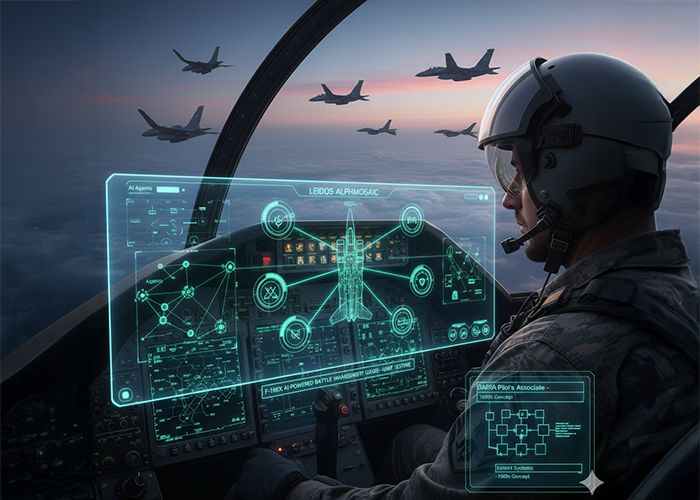
Introduction
The Association of the United States Army (AUSA) held its annual meeting this week in Washington, D.C. Amid an upswing in emerging defense technology – and artificial intelligence (AI) especially – a number of companies displayed new software and software-defined systems.
Notably on the agenda this year was autonomy and piloting software. Northrop Grumman showcased its Beacon Project – an autonomy software testbed with project partners including Applied Intuition, Merlin, and Soar Tech. Shield AI showcased its Hivemind software that undergirds that company’s efforts to instantiate autonomy on platforms including the V-BAT, MQ-20, and F-16 VISTA. Anduril was likewise present, with the company’s Lattice Mesh software contributing to the Army’s Next Generation Command and Control (NGC2) modernization.
Of particular interest was Leidos’ AlphaMosaic AI-powered Battle Management software, which has been demonstrated on the F-15EX. Developed within the Defense Advanced Research Projects Agency’s (DARPA) now-completed Air Combat Evolution (ACE) program, AlphaMosaic is now undergoing testing with the U.S. Air Force (USAF).
AI Piloting’s Earlier Moment in the Sun
AlphaMosaic is a new attempt at an old idea. DARPA funded an earlier attempt beginning in 1983 with its ambitious Strategic Computing Program, aiming to develop a Pilot’s Associate that would assist pilots during all cockpit decision-making and planning processes. It was to be underpinned by a combination of AI (software), novel hardware, and natural language understanding capabilities. DARPA planners sought to underpin the PA with five Expert Systems, underpinned by Symbolic AI, working in tandem across mission planning, system status, situation assessment, tactics, and front-end communication with the human pilot.
This PA had to overcome obstacles in real-time processing via sufficiently powerful computing hardware and limited vocabulary understanding in a noisy environment. While progress was made – often with longer-term and incremental impacts on areas like speech recognition – the PA failed to function with sufficient robustness in real-world situations. The underlying Expert Systems could not effectively coordinate with one another, sometimes delivering contradictory recommendations to the human pilot. They likewise could not make sense of certain aircraft maneuvers and could not deliver accurate predictions of their resulting geometries.
Leidos Chases the Dream
Leidos’ AlphaMosaic is a close parallel to DARPA’s Pilot’s Associate dream. The company in fact references a suite of intended abilities relevant to AI-assisted piloting reminiscent of DARPA’s 20th century initiative: Leidos is focused on building a system capable of coordinating and communicating across domains for machine-generated, effective responses, targeting, and aerial refueling dynamics.
Demonstrated successfully on the F-15EX as part of DARPA’s ACE program, AlphaMosaic is now testing with the USAF, with an eye toward fielding in 2027. In the short-term, Leidos notes a focus on securing a contract with the U.S. Space Force to cross reference data with satellite information, enabling AlphaMosaic to direct relevant data, threats, and responses to the appropriate commands and squadrons within the U.S. Air Force. Looking ahead, it plans to extend these capabilities across domains as well as toward missile and drone integration.
AlphaMosaic has an interestingly similar conceptual design to Strategic Computing’s Pilot Associate, though with important, less visible differences. The 20th century’s PA project was an ensemble approach to AI piloting – Expert Systems, based on the preferred AI techniques of the time, were to coordinate with one another to deliver the desired capabilities. AlphaMosaic appears to borrow – at a high level – this ensemble approach by having AI “agents” coordinate with one another. Technical details about the techniques underpinning these agents is publicly unavailable, but one can safely assume a pivot in this case to neural network-based agents that provide for flexible application, perhaps melded with hard-coded rules provided by human programmers.
The Future of AI Piloting
The future of AI piloting will likely reflect a fundamental cost-to-risk calculation: the more dispensable the platform, the more amenable to full AI control. As the cost of fighter jet platforms is too great and the underlying technology too immature for complete trust, the dominant trend in AI piloting will skew towards the development of co-pilot and battle management programs.
These more limited approaches utilize AI for maximum tactical advantage, while retaining a human in the loop. AlphaMosaic – and any of the other similar ongoing efforts – must still face the prospect of a technology that works well in a standalone capacity within tightly controlled conditions may ultimately collapse in the real-world.
Ultimately, maintaining measured expectations of what AI can reliably accomplish will likely make this iteration of AI piloting more successful. This is a crucial lesson learned from the Strategic Computing Initiative: systems that overpromise on generalized intelligence will fail to integrate into real-world combat operations. By limiting AI piloting and decision-making to clearly specified and validated roles – these new programs can succeed where the PA failed.





